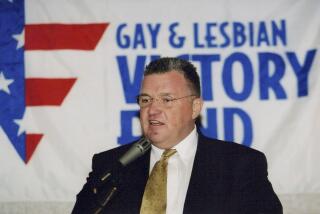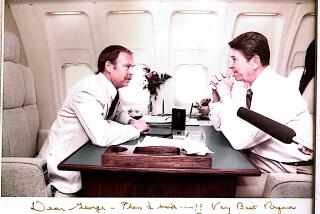George B. Leonard dies at 86; journalist a seminal figure in the human potential movement
George B. Leonard, a journalist whose prescient reporting on California’s cultural upheavals led him to popularize the philosophies and practices of the human potential movement as one of its early leaders, died Jan. 6 at his home in Mill Valley, Calif. He was 86.
Leonard had been ill for several years, said his wife, Annie Styron Leonard.
A senior editor of Look magazine, he came to California from the East Coast as the Eisenhower era was ending and picked up the rumblings of changes that would shake American society in the next decade. His articles forecast the discontent of youths before there was a free speech movement and described California’s role as the incubator of a consciousness revolution before “encounter group” and “let it all hang out” joined the lexicon.
“He was a great social observer,” said Michael Murphy, who in 1962 co-founded the Esalen Institute, the Big Sur retreat center that became a world-famous magnet for seekers of self-awareness. Leonard, who later served as Esalen president, often said the term “human potential movement” was coined during a brainstorming session with Murphy in 1965.
Murphy said he isn’t sure that was how the term arose, but he is certain that Leonard did more than anyone else to make it widely known. “He gave names to things. He helped publicize that whole idea that this was a movement,” Murphy said.
By the time Leonard left Look in 1970 he was immersed in the movement, eventually becoming what Murphy called an “inventor of transformative practices” aimed at harmonizing and maximizing mental, physical and spiritual awareness.
A fifth-degree aikido black belt, he created the aikido-inspired Leonard Energy Training, a series of exercises that taught alternative methods for dealing with pain, conflict and stress. In the 1990s, he and Murphy developed another mind-body regimen, called Integral Transformative Practice. He also helped run Esalen’s first interracial “encounter” groups, emotionally bruising sessions in which blacks and whites challenged one another’s racial beliefs to foster better relations.
Leonard wrote a dozen books, including “The Transformation: A Guide to the Inevitable Changes in Humankind” (1972), “The Silent Pulse: A Search for the Perfect Rhythm That Exists in Each of Us” (1978), “The End of Sex: Erotic Love After the Sexual Revolution” (1983), “Walking on the Edge of the World” (1988) and “The Ultimate Athlete” (2001).
Leonard was born Aug. 9, 1923, in Macon, Ga. The grandson of a state senator who owned black tenant farms, he awoke to the need for racial equality as a youth when he saw a mob trying to lynch a black rape suspect. After serving as a combat pilot in World War II and the Korean War, he joined the staff of Look in 1953 and soon was reporting on the civil rights movement.
“He wrote a fascinating story about what black people do at night as a way of telling us how little we knew about them,” recalled T. George Harris, a Look colleague who later became founding editor of Psychology Today. With Harris and Christopher S. Wren, Leonard produced a memorable, hour-by-hour account of the integration of the University of Mississippi in 1962.
That year he also edited a special issue of Look on California that portrayed the state as a laboratory for “the society of the future” that was cultivating a new kind of person. In a 1964 story titled “Revolution in Education,” he used the phrase “human potential,” which drew excited responses from scores of readers.
Convinced he had hit on the next big topic, Leonard crisscrossed the country for eight months, interviewing philosophers, psychologists, psychiatrists, theologians and brain researchers for a story he planned to call “The Human Potential.” One of the people he encountered was Murphy, who had founded Esalen with fellow Stanford graduate Richard Price a few years earlier.
“That meeting,” Leonard said later, “changed my life.”
He and Murphy found they were on the same wavelength about the changes that were beginning to ripple through society, and they began to meet regularly for brainstorming sessions. “At one point I said, ‘How about this: We’ve got a civil rights movement and we’ve got a free speech movement. . . . How about a human potential movement?’ So I just wrote it down and threw it on the floor. I guess that was the beginning of it,” Leonard told author Russell E. DiCarlo in “Towards a New World View: Conversations at the Leading Edge” (1996).
Leonard summed up the mission of this new movement in an essay he wrote for Esalen’s fall 1965 catalog: “We stand on an exhilarating and dangerous frontier -- and must answer anew the old questions: What are the limits of human ability, the boundaries of the human experience? What does it mean to be a human being?”
By the end of the decade, public misunderstandings of the movement he helped promulgate were so prevalent that to many it meant getting naked in hot tubs with strangers or screaming primal insults at one another. He and Murphy “looked around and said, ‘My God, this is not what we had in mind at all,’ ” he told DiCarlo. “So we said, ‘Let’s un-name this movement.’ We told others there was no such thing as the human potential movement. But we found that it’s much harder to un-name a movement than it is to name it.”
In addition to his wife, Leonard is survived by three daughters, Emily Graim of Phoenix, Burr Leonard of Sausalito, Calif., and Mimi Fleishman of Los Angeles; two brothers; and six grandchildren.
More to Read
Start your day right
Sign up for Essential California for the L.A. Times biggest news, features and recommendations in your inbox six days a week.
You may occasionally receive promotional content from the Los Angeles Times.







